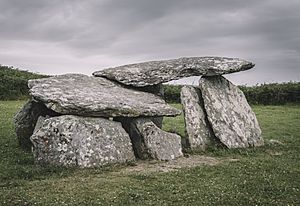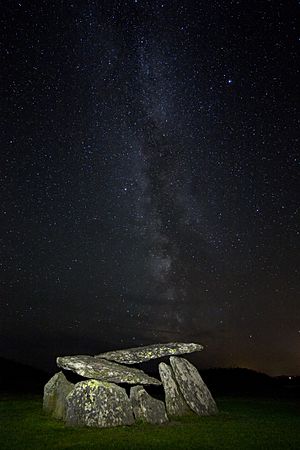Altar Wedge Tomb facts for kids
Quick facts for kids Altar Wedge Tomb |
|
|---|---|
| Native name Irish: Tuama Dingeach na hAltóra |
|
| Altar Cromlech | |
 |
|
| Type | wedge-shaped gallery grave |
| Location | Altar, Schull, County Cork, Ireland |
| Built | c. 2500 BC |
| Official name: Altar Wedge Tomb | |
| Reference no. | 645 |
| Lua error in Module:Location_map at line 420: attempt to index field 'wikibase' (a nil value). | |
The Altar Wedge Tomb is an ancient burial place located in County Cork, Ireland. It is a special type of tomb called a wedge-shaped gallery grave. This important historical site is also a National Monument, meaning it is protected by the government. It was built a very long time ago, around 2500 BC.
Contents
Where is the Altar Wedge Tomb?
The Altar Wedge Tomb is found about 6.7 kilometers (4.2 miles) west-southwest of Schull. It sits right on the edge of a cliff, close to a beautiful area called Toormore Bay.
History of the Ancient Tomb
When Were Wedge Tombs Built?
Wedge tombs, like the Altar Wedge Tomb, were built in Ireland during a time called the late Neolithic period and the early Bronze Age. This was roughly between 2500 BC and 2000 BC. The Neolithic period was when people first started farming, and the Bronze Age was when they began using bronze tools.
Burials and Rituals at the Tomb
People used this tomb for burials around 2000 BC. They would cremate (burn) bodies and bury the ashes here. Later, around 1200 BC, people buried bodies directly in pits.
Around AD 200, a pit was dug at the site. It was filled with bones from fish, shellfish, and even large sea animals like whales or dolphins. This was likely part of a special ritual or ceremony.
The Name "Altar"
Even though it's called the "Altar" Wedge Tomb, there's no proof it was ever used for sacrifice. However, in the 18th century AD, it was used as a Mass rock. This means people gathered there secretly to hold religious services. A holy well, which is a special spring of water, was also located nearby across the road.
Discoveries from Excavations
In the summer of 1989, scientists Dr. William O'Brien and Madeline Duggan carefully dug up parts of the tomb. This process is called an excavation. They found many interesting things. These included bones from cremated adult humans and a tooth. They also found worked flint (a type of stone used for tools), charcoal (burnt wood), and bones from sea creatures like periwinkles and limpets. Fish bones were also discovered.
What Does the Tomb Look Like?

The entrance of the tomb faces east-northeast to west-southwest. This direction might have been chosen to line up with Mizen Peak, a nearby mountain. It might also have been set up to catch the setting sun on Samhain, an ancient festival celebrated around November 1st.
The main part of the tomb is called a gallery. It's shaped like a trapezoid, which means it's wider at one end than the other. The gallery is about 3.42 meters (11.2 feet) long. It's 1.9 meters (6.2 feet) wide at the west end and 1.25 meters (4.1 feet) wide at the east end.
One large roof-stone, about 2.7 meters (8.9 feet) long, still sits above the east end of the tomb. Another stone rests against the side stones at the western end. There isn't any evidence of a stone mound (called a cairn) or special border stones (kerbstones) around the tomb. These might have been removed when roads were built in the 1800s.

